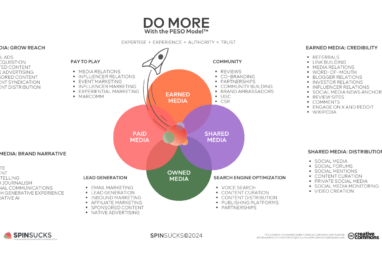Creating your global community of storytellers
Companies can no longer rely on creating one-way communications – it’s time to tap into external voices.
About the author
Guest author Lucinda Neal shares her CIPR Professional PR Diploma thought leadership article.

There’s a revolution disrupting digital communications. From a grassroots movement, user-generated content has been embraced by big business with an eye to the horizon.
It’s a hot topic and big money. Many platforms monitor social conversations to collect and curate user-generated content alongside owned and paid-for, compiling libraries and insights to improve its distribution. Take three: in 2016, Olapic and Livefyre were acquired by Monotype and Adobe respectively, while Stackla pulled in $10m.
Boosting sales through consumer content is not new. Recommendations and reviews are its most basic form. Travel booker TripAdvisor provides an early online example and model for business interactions with a social media community.
In its 2013 survey, an appropriate management response to a bad review gave a favourable impression for 87% of travellers, while a defensive reply made 70% less likely to book. Almost two-thirds were more likely to book a hotel that responded to reviews than one that didn’t. An independent study, suggesting improved ratings are directly linked to management responses, backs this up. (See “Replying to Customer Reviews Results in Better Ratings”, HBR, February 2018.)
The message is to engage with social media followers. They often come from a company’s top priority stakeholder group – typically customers, but social media is used by various influencers. Level three stakeholders according to Andrew Griffin’s model – including the media, experts and interest groups – influence the powerful first and second priority stakeholders, and will pick up on themes or issues on a company’s social media channels. Therefore, by offering useful, informative content, a company can set the agenda. This is convenient in crisis management as a quick initial broadcasting method to reach wider stakeholders.
By ‘user-generated content’, people typically mean that created by consumers – usually photos, Millennials’ most produced content. Don’t forget ‘third priority’ stakeholders, who can create earned content, from articles to surveys, reports and videos, to influence your most powerful stakeholders.
Figuring out which digital channels are best for your brand and making sure it has a social media presence is the first step. If you are not already involved, discussions with the communications team can familiarise you with the reasons behind the company’s existing digital strategy.
Consumers expect that if they share personal content on social media to help promote a brand, the brand will reply where warranted. For social media contact, it’s good to see what other companies are doing, but there’s no ‘one size fits all’. A key decision is when to be involved in the conversation, remembering that cultivating any community is about connecting with a range of people, not just dealing with complaints out of reputational fears and ignoring your number one fans.
“If people feel listened to, they become more receptive to your message,” writes Nancy Duarte in Influence and Persuasion (Harvard Business Review Press, 2018). “And by doing the listening you become more informed about what they really need – not just what you think you need – which will fuel your relationships with stakeholders over the long run.”
The definition of trustworthiness
When people make a purchase, they look increasingly to the views of others like them, friends and family. In a survey reported in Stackla’s 2017 Consumer Content Report, 86% of consumers said authenticity is important when deciding which brands to support. Nearly three times as many are influenced in their purchase decisions by content from friends and family than are influenced by celebrities or ‘influencers’.
What’s at stake if you don’t embrace authenticity? Firstly, consumers are savvier than ever about digital media. On average people can identify if an image was created by a professional or a consumer 70% of the time. Inauthenticity is a no-no: 20% of consumers have unfollowed a brand on social media due to inauthentic or corporate content that doesn’t hit the right note, rising to 30% among Millennials.
An unfollow doesn’t necessarily mean less likelihood of purchasing your product, but your brand will be less visible to this audience, and people are more likely to recall the most familiar brands at the relevant moment of purchase or during product research.
Inauthenticity will also make you less likeable, and companies that do best on social media are the ‘firms of endearment’, as termed by Peter Mountstevens, managing partner at brand communications agency Taylor Herring. “Consumers have taken these brands to their hearts, they follow them on social media and enjoy hearing from them. They have become a friend (of sorts) and there is a commercial reason for this strategy. You are more likely to buy from a ‘friend’ than someone you don’t know.”
‘Liking’ is also one of the six principles of persuasion set out by influence specialist Dr Robert Cialdini. “It’s much easier to build support for a new project when the people you’re trying to persuade are already inclined in your favour.”
Edelman’s 2018 Trust Barometer reveals a less straightforward picture. Friends and family are trusted sources of advice on product purchases or holiday destinations, but if your business trades on information and expertise then you should look elsewhere for endorsement.
Trust in journalism is growing
It might be more worthwhile to engage with traditional earned media. Journalists are enjoying higher levels of perceived credibility, rising 12 points in the Trust Barometer since 2017. Trust in journalism jumped five points while trust in platforms, including social media, dropped by two. It might therefore seem paradoxical for journalists to be in the social media space, but falling trust is due to fake news shared by peers or sources seen as less credible than media experts. This is different from the first-hand reportage of peers.
In an age where nearly seven in 10 people worry about fake news or false information being used as a weapon, as reported by Edelman, people are seeking out expertise once more.
CEOs recorded a seven-point gain in the barometer, with technical experts, financial industry analysts and successful entrepreneurs at 50% credibility or higher. Authority is another of the principles of influence, and senior leaders can lend their voices to online earned content, whether news articles or specialist blogs, to add a stronger message, going through the company’s usual media relations channels.
Crowd-sourcing content
Engaging with other influencers as well as journalists can generate third-party earned content that can be amplified on social media and other channels.
The buzzword ‘influencer’ conjures up an image of a vlogger with a mass social media following. Teaming up with these expert social media users may well pay off, particularly when they are engaged thoughtfully as part of a campaign. During Warner Brothers’ 2016 promotional event at VidCon, nine YouTube creators created unique videos to promote Fantastic Beasts and Where to Find Them. They also participated in a live-stream panel attracting over 30,000 participants, all sharing information through social media.
Crowdsourcing can be even more inclusive, as the beauty industry has demonstrated for years, with beauty fans invited to name and formulate products by Charlotte Tilbury and Glossier among others.
It usually results in a range of varied, innovative content with wide appeal – and which its creators are keen to promote, to showcase their expertise. Partnering with relevant influencers means you can also tap into their follower networks. Just remember that it’s about the authenticity, not paid-for celebrities.
Widening the playing field
If your company deals in travel and hospitality, user-generated content is a very easy win, with people keen to share their positive travel, food and beverage experiences on social media. Nearly 52% of people say they post on social media at least once a month about products they’ve bought. There are nearly two billion photos shared on social media daily, with consumers generating an average of 95 million posts in a day.
Virgin Holidays achieved a 260% increase in online bookings and 64% more passengers year on year through user-generated content, notably its 2016 Black Friday campaign #RedistheNewBlack with Stackla. This involved asking users to tweet @virginholidays with the hashtag within an eight-hour period, during which its website revealed unique and increasingly generous offers that were unlocked as the number of tweets grew and hit various thresholds. Once the 3000 tweet mark was reached, those that had tweeted the hashtag were entered into a competition to win a holiday for £100.
As well as increasing user-generated content for your brand, competitions and reward offers add incentive. Businesses can tap into ‘gamification’, with game mechanics motivating people to participate, and competition plays on reciprocity, one of Cialdini’s principles of persuasion. If people receive a prize, they are more likely to ‘repay in kind’ by purchasing – and even the chance to win the prize can be seen as an incentive.
Some ideas are so good that everyone wants a piece of them. Red Bull’s #PutACanOnIt campaign won the Shorty Awards Hashtag category for its ingenuity and playfulness – not accidentally some of the brand’s core values. Inspired by a photo on Twitter with a Red Bull can placed to appear as if on a distant Mini Cooper, like a Red Bull Mini, the brand invited people to imitate the idea. Its cheeky simplicity caught people’s imaginations and led to almost 10,000 original photos being uploaded to Instagram and Twitter in the first few months. When Pepsi posted a similar photo with one of their cans, and Red Bull responded by superimposing its can and adding #PutACanOnIt, friendly rivalry ensued, with Perrier later involved. This captured consumer imagination.
It’s no coincidence that both Virgin and Red Bull are expert storytellers. “Every brand has a story,” says Taylor Herring’s Peter Mountstevens. “On a basic level this is… rooted in the service they provide, their reason for being and the history of the company. These foundations combined with customer insights allow brands to distil a personality with a distinct tone of voice and a clear view of their position and the world they exist in.”
Red Bull has its own TV and music studios, creates newsworthy stunts and invents its own sports. “It ensures it remains a relevant and exciting part of the cultural conversations its consumers are having.” This is how it became the most shared social video brand in 2016.
Rethinking channels
User-generated content is versatile. Once you’ve amassed your content library, think laterally about how it can transpose to more traditional marketing channels. This is crucial given that consumers use three channels or more when researching a purchase.
Apple’s #ShotOniPhone integrated campaign has a simple product quality message and started with high-resolution images on traditional billboards alongside the tagline ‘shot on an iPhone’. It later opened its @apple Instagram account, featuring only user-generated images posted with the hashtag. The simplicity of the idea and the tag means this has entered mass consciousness from inception, even among those without an iPhone, and taken on a life of its own – continuous user-generated content without the brand’s continued intervention.
A delicate balance in a tough world
It’s an exciting time for businesses who embrace earned content in all its forms. Publicity possibilities are almost limitless, but with this comes the need for shrewd specialist communicators to proactively identify opportunities and help uphold the company’s reputation. Businesses need to take the same responsibility as a publisher would for the quality and trustworthiness of the content they share.
It’s important not only to embrace technological platforms, but also to invest in human communicators who can maximise the rewards and dial down the risks.
One risk is the issue of data, on the news agenda after personal data was harvested from unwitting consumers through social media apps. Discussing data privacy with any platform providers you work with is vital, particularly in light of the forthcoming General Data Protection Regulation (GDPR).
On the flip side, legally using analytics to identify trends will keep you ahead of the curve. “Research on economic profit distribution highlights… a power curve that has been getting steeper over the past decade and is characterized by big winners and losers… A small number of winners—often in high tech and media—are actually doing better in the digital era than they were before. They marshal huge volumes of customer data drawn from their scale and network advantages. That triggers a virtuous cycle.” (See ‘Why digital strategies fail’, McKinsey Quarterly, January 2018)
It’s a brave new world for content. Its ‘democratisation’ and changing algorithms can create echo chambers of limited messages and opinions depending on consumers’ online viewing preferences.
In this new landscape, the best digital strategies will build stronger connections with the general public that will work harder than native content or a celebrity campaign, at lower cost. Professional creators will be freed up to produce quality content to set the narrative for the company story and launch the initiatives to inspire the public as brand ambassadors.
Too many companies “underestimate the increasing momentum of digitisation, the behavioural changes and technology driving it, and…the scale of the disruption bearing down on them.” (‘Why digital strategies fail’). Recent years have witnessed a sea change in communications, and it makes sense to master the waves before the rip tide hits.
This article was submitted as part of an assignment for the CIPR Professional PR Diploma with PR Academy.


